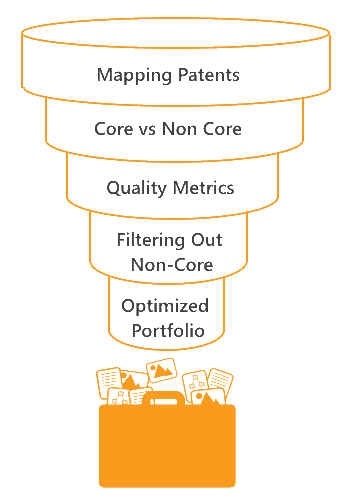Share
Share

Patent Portfolio Pruning
Patent Portfolio Pruning (also called as patent portfolio optimization) is an important periodic activity undertaken by IP Managers who constantly face IP budget constraints. Various activities like mergers and acquisitions, buying or selling of products can create redundancies in the patent portfolio. Also with time, some patents may become non-core to a business. IP managers should maintain a patent portfolio that is aligned to the core business strategy and let go of patents that are not relevant to the business thereby saving on the maintenance and annuity fees. IP budgets are fixed, and maintenance of patents is a costly affair. The saved money can be used for R&D activities, new IP filings, etc. This is where patent portfolio optimization or portfolio pruning comes into picture.
This process involves an analysis of the currently active patents in a portfolio with the aim of classifying them as core, non-core (or supplementary) patents. Mapping of patents to products and key research areas will help in understanding which patents are the core of the product or business lines. Leveraging qualitative scores provided by databases such as PatSeer can help in giving you a head-start on your evaluation and save time
The Patent Portfolio Pruning Process
To begin with, you must first determine which patents are core and non-core to your business. Mapping patents to end products and key research areas help in understanding the core patents that protect your business. If you do not already have your portfolio mapped against an internal taxonomy then you can leverage tools such as IPC/CPC Mapping, technology clustering or topic maps to help speed up the process. Taking feedback from the inventor or relevant R&D team member can also be useful in determining the patent-technology mapping.

At any stage of those patents or inventions that are deemed to be critical can safely be removed from further analysis. For the remaining it becomes useful to leverage quality metrics to get an idea of the potential they hold. Some of the important contributing parameters are:
- Forward citations in the last 5 years
- IPC, CPC diversity of forward citations
- Forward assignee spread
- Patent family coverage
- Patent life cycle (remaining life of a patent)
Patents not belonging to the core of the business and also ranking lower on the quality metrics can be further studied before you decide to abandon them. The aim here is to decide the licensing or infringement potential of the patents and a few of the considerations here are:
- Scope of claims (whether claims are narrow or broad) – Broader claims can increase licensing probability in areas not directly competitive with your business
- Current and future market size of the technology in which the patent falls into
- Whether the patented technology is being used by third-party products
- Whether the technology field is in demand, and a lot of research is going on in that area
Those that show promises can be further evaluated for monetization by way of licensing, enforcement, or sale. Finally, those patents that are non-core, lower in quality ranking and which do not have any licensing or enforcement potential are ripe for abandonment.
Keep in mind that pruning can also be done for patents that continue to be part of your product subject to the following criteria:
- If the process or technology protected by the patent is having a clear workaround
- If a prior-art has come to light that can invalidate the patent easily
- If a country, no longer holds any commercial potential for your product/technology (Country-specific pruning of family members can be evaluated)
To sum-up, having systematic approach to the portfolio pruning process can go a long way in keeping you IP portfolios aligned with the latest goals of the business. Leveraging the best tools of patent qualitative analysis can help mitigate some of the challenges associated with this time-consuming process.




